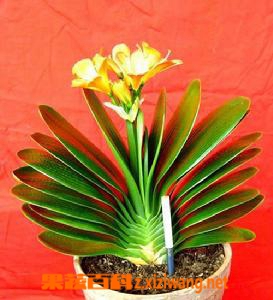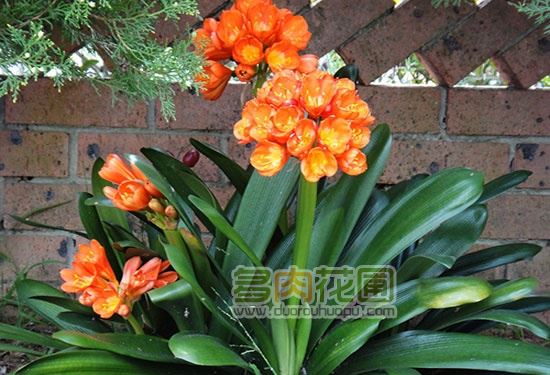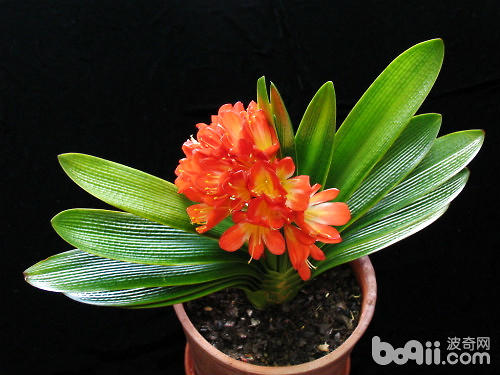How to deal with the rotten root of the gentleman orchid?
Clivia rotten roots how to deal with, Clivia is a succulent root plants, if the environmental conditions are poor or improper maintenance, often cause root rot. In general, seedlings often rot from below the base of the leaf, while mature plants rot from below the middle of the root. There are many reasons for the root rot of Clivia, mainly:
1. Improper fertilization. Application of undecomposed organic fertilizer;
2. Too much watering. Especially in summer high temperature and winter indoor ventilation and low temperature easily lead to rotten roots;
(3) The basin soil is poor. The improper proportion of culture soil makes the pot soil harden and causes long-term waterlogging damage to roots in the pot.
4. Pathogenic infection. Clivia sub-plant, the wound is not disinfected, so that bacterial infection caused by rotten roots.
Clivia root rot may occur in each growth period, light plant weak leaves yellow, heavy whole plant death. If you find rotten roots of plants should immediately knock out the diseased plants from the basin, gently strip the soil with clean water, and then cut off the rotten roots, after disinfection with 0.1% potassium permanganate, take out a little plant ash, or with carbendazim smear wounds, put in the shade to dry the wounds, the above is about how to deal with the rotten roots of Clivia introduction.
How to deal with the rotten roots of Clivia
Clivia is one of the most common indoor flowers, partly because its appearance is more elegant, placed indoors not only has a decorative role, but also brings some green visual enjoyment, decorate the home most suitable. Another part of the reason is the meaning of clivia, gentleman noble can not be bullied, even in modern society, there are many people to clivia symbol of their own character, compared to some flowers and plants, clivia appears elegant and atmospheric. However, in the daily breeding process, Clivia often has some rotten roots, which looks very uncomfortable. What about the rotten roots of clivia? The answers are below.

How to deal with the rotten roots of Clivia
1. Under normal circumstances, because the overall growth conditions of Clivia are relatively common, it is also a plant with strong vitality, so unless there are some relatively large mistakes in the breeding process, such as excessive water, it may lead to the occurrence of rotten roots in Clivia, affecting growth, generally as long as the corresponding breeding method is mastered, Clivia can be reasonably avoided.
2, but in case there is really a situation of Clivia rotted roots is no way to remedy it, of course not, we have already said that Clivia is a very strong vitality of the plant. Therefore, even if there is a rotten root situation, there are ways to remedy it, so that we will not waste a life, we can continue to cultivate and enjoy the beauty that Clivia brings us.
3. The remedy for the rotten roots of Clivia is roughly to pour out the whole Clivia, then wash away the soil of the roots of Clivia, and then remove the rotten roots. Dry the water in the sun until the orchid roots are slightly soft, take new soil and re-pot, pour enough water and put it in a cool place. Here we should pay special attention to the soil to use dry soil, wet soil not only can not save clivia, but also may aggravate rotten roots oh.
How to deal with the root rot of Clivia in the home life, many families will cultivate some flowers at home, such as orchids, poinsettias, etc., among which, Clivia is the most popular, but many families will appear rotten root situation, then, how to deal with the root rot of Clivia? What are the ways to deal with the rotten roots of Clivia? Follow the provincial decoration network Xiaobian to see it, I hope to help everyone. 1. Most of the roots of Clivia are still good, only a part of the roots are rotten. The rescue method for this situation is: immediately knock them out of the basin after discovering the rotten roots, remove the attached soil, rinse the roots with clean water, and then remove the rotten roots with a clean shaving blade; Then apply 0.1% potassium permanganate solution to the rotten roots (or apply charcoal powder, cigarette ash, etc.), dry in the shade for 3 to 5 hours, and then directly plant them in the disinfected humus soil retting with pine needle leaves or in the fully decomposed sawdust or mountain mud basin.
After planting, cover the basin mouth with transparent plastic bag, put it in semi-shade, water less, keep the basin soil slightly moist. At the same time, every 5~7 days, spray 0.2% potassium dihydrogen phosphate aqueous solution on the leaves to increase nutrients and promote rooting. After more than two weeks, new roots can grow, at which point the bagging is removed and gradually transitioned to normal maintenance.
2. Most or all of the roots of Clivia have rotted. The rescue method for this situation is: first rinse the stem base with water, then cut off the rotted part transversely with a sharp knife (the incision is required to be smooth), and then apply sulfur powder or charcoal powder at the incision to prevent wound infection. Put it in a cool and ventilated place;
After the surface of the incision is slightly dry, plant it in a plain sand pot. After two days, pour water once. After that, keep the pot soil moderately moist and avoid fertilization. At 20~25℃, new roots will grow around the incision after about 10 days, and can be transplanted into new culture soil pots after 50 days, and gradually transferred to normal maintenance.
related articles
- Prev

What if the leaves of Cymbidium turn yellow?
Gentleman orchid sword leaves are vigorous, bright green and beautiful flowers, but the leaves often turn yellow due to improper management, affecting the ornamental effect. This paper briefly describes the causes and control methods of the yellow leaves of Cymbidium as follows: the reason for the yellowing of Cymbidium leaves 1: lack of water for a long time or only half of the water at a time.
- Next

Why don't magnolia blossom?
Why does the orchid not blossom? when it comes to the flowering age, the orchid can not blossom normally, mainly for the following reasons: too much ① nitrogen fertilizer, less phosphorus and potassium fertilizer, and no bud when the bud blossoms. Excessive sunlight in summer in ② has an adverse effect on the flowering of pregnant buds. ③ is placed in a place where the temperature is too high in winter
Related
- Fuxing push coffee new agricultural production and marketing class: lack of small-scale processing plants
- Jujube rice field leisure farm deep ploughing Yilan for five years to create a space for organic food and play
- Nongyu Farm-A trial of organic papaya for brave women with advanced technology
- Four points for attention in the prevention and control of diseases and insect pests of edible fungi
- How to add nutrient solution to Edible Fungi
- Is there any good way to control edible fungus mites?
- Open Inoculation Technology of Edible Fungi
- Is there any clever way to use fertilizer for edible fungus in winter?
- What agents are used to kill the pathogens of edible fungi in the mushroom shed?
- Rapid drying of Edible Fungi

